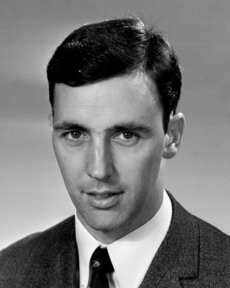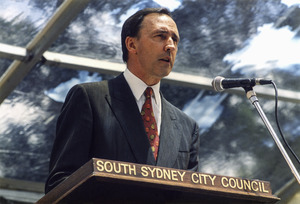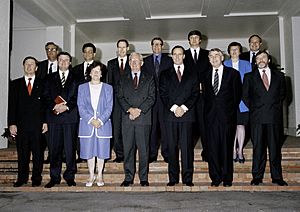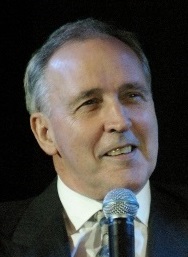Paul Keating facts for kids
Quick facts for kids
Paul Keating
|
|
|---|---|
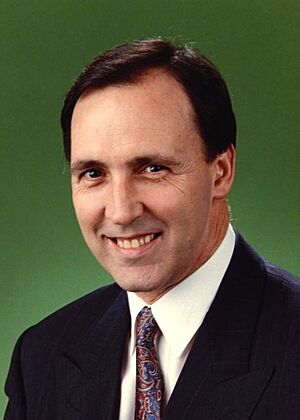
Official portrait, 1993
|
|
| 24th Prime Minister of Australia | |
| In office 20 December 1991 – 11 March 1996 |
|
| Monarch | Elizabeth II |
| Governor General | |
| Deputy | |
| Preceded by | Bob Hawke |
| Succeeded by | John Howard |
| 14th Leader of the Labor Party | |
| In office 19 December 1991 – 19 March 1996 |
|
| Deputy |
|
| Preceded by | Bob Hawke |
| Succeeded by | Kim Beazley |
| Deputy Prime Minister of Australia | |
| In office 4 April 1990 – 3 June 1991 |
|
| Prime Minister | Bob Hawke |
| Preceded by | Lionel Bowen |
| Succeeded by | Brian Howe |
| Deputy Leader of the Labor Party | |
| In office 4 April 1990 – 3 June 1991 |
|
| Leader | Bob Hawke |
| Preceded by | Lionel Bowen |
| Succeeded by | Brian Howe |
| Treasurer of Australia | |
| In office 11 March 1983 – 3 June 1991 |
|
| Prime Minister | Bob Hawke |
| Preceded by | John Howard |
| Succeeded by | John Kerin |
| Minister for Northern Australia | |
| In office 21 October 1975 – 11 November 1975 |
|
| Prime Minister | Gough Whitlam |
| Preceded by | Rex Patterson |
| Succeeded by | Ian Sinclair |
| Member of the Australian Parliament for Blaxland |
|
| In office 25 October 1969 – 23 April 1996 |
|
| Preceded by | Jim Harrison |
| Succeeded by | Michael Hatton |
| Personal details | |
| Born |
Paul John Keating
18 January 1944 Darlinghurst, New South Wales, Australia |
| Political party | Labor |
| Spouse |
Annita van Iersel
(m. 1976; div. 2008) |
| Domestic partner | Julieanne Newbould (1999–present) |
| Children | 4 |
| Residences | Potts Point, New South Wales, Australia |
| Education |
|
| Profession |
|
| Signature |  |
Paul John Keating (born 18 January 1944) is an Australian former politician. He was the 24th prime minister of Australia from 1991 to 1996. He was also the leader of the Labor Party. Before becoming prime minister, he served as Treasurer from 1983 to 1991. He was also the Deputy Prime Minister from 1990 to 1991.
Keating was born in Sydney and left school at 14. He joined the Labor Party at the same age. He worked as a research assistant for a trade union. At 25, he was elected to the Australian House of Representatives in 1969. He briefly served as Minister for Northern Australia in 1975. After Labor lost power, he held important roles in the opposition team. He became known as a strong and skilled speaker in Parliament.
After Labor won the 1983 election, Prime Minister Bob Hawke made Keating the Treasurer. They worked together to make big changes to Australia's economy. These changes included letting the Australian dollar's value change freely. They also removed taxes on imported goods and made banking rules simpler. Keating became Deputy Prime Minister in 1990. In 1991, he challenged Hawke for the leadership and won, becoming prime minister.
Keating became prime minister during an economic downturn. Many thought Labor would lose the 1993 election. However, Keating's government won a surprise victory. During his time as prime minister, he introduced the Native Title Act. This law recognized the land rights of Indigenous Australians. He also brought in compulsory superannuation, which helps people save for retirement. His government also sold off some government-owned companies like Qantas. He also helped create the APEC leaders' meeting.
In the 1996 election, Keating's government lost badly to John Howard's party. Keating then resigned as Labor leader and left Parliament. Since then, he has continued to share his political opinions. He has also been involved in business.
Keating's time as prime minister had mixed reviews. However, he is widely praised for his work as Treasurer. He helped modernize Australia's economy. He is also remembered for his strong speaking style. His famous Redfern Park Speech talked about the impact of European settlement on Indigenous Australians.
Contents
Early Life and Education
Paul Keating was born in Darlinghurst, Sydney, on 18 January 1944. He was the oldest of four children. His father worked as a boilermaker for the railways. Keating grew up in Bankstown, a working-class area in western Sydney. His family home was a simple house.
Keating's family was Catholic. This background influenced his views on society. He left De La Salle College at 14. Instead of going to university, he worked as a pay clerk. He also attended Belmore Technical High School. He joined the Labor Party as soon as he could. In 1966, he became president of New South Wales Young Labor. In the 1960s, Keating also managed a rock band called The Ramrods.
Starting His Political Journey
Through his connections in unions and Young Labor, Keating met other future Labor leaders. He also became friends with former New South Wales Premier Jack Lang. Lang became Keating's political mentor. In 1969, Keating was elected to the Australian House of Representatives for the area of Blaxland. He was only 25 years old.
Keating was first elected as a backbencher. This means he was a regular Member of Parliament, not a minister. In October 1975, he became Minister for Northern Australia. But he only held the role for a short time. This was because the government was removed from power by the Governor-General.
After Labor lost the 1975 election, Keating quickly joined the opposition's main team. He was the Shadow Minister for Minerals, Resources and Energy until 1983. During this time, he became known as a strong and aggressive debater in Parliament. In 1981, he became president of the New South Wales Labor Party. This made him a leader of an important group within the Labor Party.
At first, Keating supported Bill Hayden for Labor Leader. But by 1982, his group supported Bob Hawke. Keating then backed Hawke's challenge for leadership. Hayden resigned a month later, and Hawke became leader. Hawke then led Labor to a big win in the 1983 election.
Australia's Treasurer
After Labor's win in 1983, Prime Minister Bob Hawke made Keating the Treasurer of Australia. He took over from John Howard. Hawke and Keating worked very well together. Many people say their partnership was key to Labor's success. Hawke and Keating were very different people. Hawke was a university graduate, while Keating left school early. Hawke liked sports, but Keating preferred classical music and collecting antiques. Despite their differences, they formed a strong bond. This allowed them to make many important changes to the government.
In their first month, Hawke and Keating held a "National Economic Summit." This meeting brought together business leaders, union leaders, and politicians. Keating explained the government's economic plans. The meeting helped the government get support for its big economic changes.
Big Economic Changes
Keating played a major role in the government's economic reforms. In December 1983, Hawke and Keating allowed the Australian dollar to "float." This meant its value would change based on the market, not be fixed. This move was very successful and gave Keating confidence to make more changes.
Over the next few years, Keating oversaw the removal of taxes on imports. He also helped sell off some government-owned companies like Qantas and the Commonwealth Bank. He made banking rules simpler, allowing more foreign banks to operate in Australia. He also gave the Reserve Bank of Australia more freedom in its decisions.
Keating also helped create the "Prices and Incomes Accord." This was an agreement between unions and the government. Unions agreed to ask for smaller wage increases. In return, the government increased social programs, like Medicare. This helped reduce inflation and unemployment. Keating's work with the Accord gave him a lot of political power. He was often called "the most powerful Treasurer in modern times."
In 1984, Keating was recognized for his economic work. He received an international award, which was known in Australia as the "World's Greatest Treasurer" award.
Tax and Spending Reforms

Keating also led a big review of Australia's tax system. In 1985, he strongly supported a new sales tax on goods and services. He believed it would help Australia's economy. However, Prime Minister Hawke decided not to go ahead with the sales tax. This was because of strong opposition from the public and unions. Even without the sales tax, the other changes made to the tax system were the biggest in decades.
Keating continued to push for changes to fix Australia's economic problems. In 1986, he famously said that if Australia didn't fix its problems, it risked becoming a "banana republic." This comment caused a lot of discussion. The government then worked harder to reduce spending. This led to Australia having a national budget surplus in 1988, 1989, and 1990. The 1988 surplus was the largest in Australian history.
During the 1987 election campaign, Keating helped Labor win a big victory. He showed a major accounting mistake in the opposition's economic plans. This mistake greatly helped Labor's vote.
Later, some people criticized Keating for high interest rates. He argued these were needed to slow down economic growth. By the late 1980s, inflation was high. Interest rates for homes reached 18%. Many believe the Reserve Bank was too slow to lower rates, which led to a recession. In 1990, Keating announced that Australia was in a recession. He famously described it as "the recession Australia had to have." This comment was controversial.
The economic changes made in the 1980s are often seen as the reason for Australia's long period of economic growth. Australia's economy grew every year for 30 years. This helped end high inflation and other economic problems.
Leadership Challenges
By late 1988, Keating believed it was his turn to become prime minister. He put pressure on Hawke to retire. Hawke refused but made a secret agreement with Keating. He promised to step down after the 1990 election. Hawke won the election and made Keating his Deputy Prime Minister.
However, by late 1990, Keating was frustrated. Hawke had not given any sign of when he would retire. Keating gave a speech that questioned the government's direction. Because of this, Hawke said he would not keep their agreement.
Keating resigned from the government in June 1991 and challenged Hawke for leadership. Hawke won the vote. Keating said he had fired his "one shot." He even thought about leaving politics. But Hawke's leadership was seen as weaker after losing Keating. In December 1991, Keating challenged Hawke again and won. He became prime minister.
Prime Minister of Australia (1991–1996)
On 20 December 1991, Keating became prime minister. He had many goals, including improving relations with Indigenous Australians. He also wanted to strengthen Australia's ties with Asia and make Australia a republic. These goals were known as his "big picture."
Indigenous Land Rights and Local Policies
Soon after Keating became prime minister, the High Court of Australia made an important decision. This was in the Mabo v Queensland case. The court ruled that native title (Indigenous land rights) existed in Australia. This overturned the idea of terra nullius (that Australia was empty land before European settlement). Keating led the government's response. He spoke often about the importance of Indigenous land rights.
On 10 December 1992, he gave a famous speech known as the Redfern Park Speech. In this speech, he openly talked about the responsibility of European settlers for harming Indigenous society. This speech is considered one of the most important in Australian political history.
This work led to the Native Title Act in 1993. This law created a system to recognize and protect native title. It also set up a commissioner to report on the human rights of Aboriginal and Torres Strait Islander peoples.
Keating also created Australia's first national cultural policy, called 'Creative Nation'. This policy provided money to support the arts in Australia. During his time, rules for mandatory detention for asylum seekers were also introduced.
Superannuation and Economic Policies
One of Keating's biggest achievements as prime minister was the full introduction of the National Superannuation Scheme. This plan aimed to help Australians save enough money for retirement. It built on policies he started as Treasurer. The scheme required employers to contribute to their employees' retirement funds.
This policy helped Australia become one of the largest holders of pension fund money in the world. It aimed to prepare Australia for an aging population.
After the 1990 recession, Keating appointed John Dawkins as Treasurer. Together, they developed an economic plan called 'One Nation'. This plan included new programs to help people find work. It also increased competition in the telecommunications industry. 'One Nation' also proposed tax cuts for middle-income workers.
Foreign Policy
As prime minister, Keating worked to strengthen Australia's relationships with its closest neighbors. He often said that Indonesia was the most important country to Australia. He made his first overseas visit to Indonesia. Keating tried to build a personal relationship with Indonesian President Suharto.
Keating also helped develop the Asia-Pacific Economic Cooperation (APEC) forum. In 1993, he convinced US President Bill Clinton and Chinese Premier Li Peng to expand APEC into a meeting for leaders. This made APEC a very important international summit. In 1994, APEC members agreed to the 'Bogor Declaration'. This set goals for increasing free trade and investment in the region.
In 1993, Keating had a diplomatic issue with Malaysia. He called Prime Minister Mahathir Mohamad "recalcitrant" (meaning stubborn or disobedient). This happened after Mahathir refused to attend the APEC summit. The word was translated in a way that made it sound worse in Malaysian. Mahathir demanded an apology, and Keating later apologized.
1993 and 1996 Elections
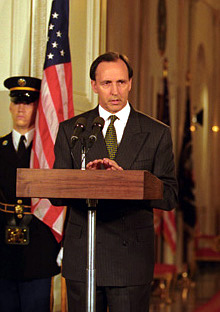
As prime minister, Keating kept his strong debating style. He often used sharp words against the opposition. Many people thought Labor would lose the 1993 election.
During the campaign, Keating strongly attacked the opposition's proposed sales tax. He argued it would harm the economy. He was helped by the opposition leader struggling to explain how the tax would work. On 13 March, Keating led Labor to a surprising fifth election victory in a row. His victory speech, starting with "This is a victory for the true believers," is still inspiring for Labor supporters.
Like Hawke before him, Keating benefited from problems within the Liberal Party. After the 1993 election, John Hewson was replaced as Liberal Leader by Alexander Downer. Downer's leadership had many mistakes. In early 1995, Downer resigned and John Howard became leader again. Howard adopted a "small target" campaign strategy for the 1996 election. He promised to keep many of Labor's reforms. This, along with a feeling that it was "time for a change," led to a big defeat for Keating's government on 2 March 1996. Keating announced he would retire as Labor Leader and from Parliament. He resigned as prime minister on 11 March.
After Politics
After leaving Parliament in 1996, Keating moved to Woollahra in Sydney. He became a director for several companies and an adviser to an investment firm. He also joined the advisory council for the China Development Bank. He received honorary degrees from several universities. In 1997, Keating declined a high Australian honor, saying that being prime minister was enough public recognition.
In 2000, Keating published his first book, Engagement: Australia Faces the Asia-Pacific. It focused on foreign policy during his time as prime minister. In 2002, his former speechwriter, Don Watson, published a book about Keating. Keating was unhappy with the book, which ended their friendship.
Keating mostly avoided public political comments at first. But before the 2007 election, he joined former Labor Prime Ministers Gough Whitlam and Bob Hawke to campaign against John Howard. He used strong language to criticize Howard.
In February 2008, after Labor won the 2007 election, Keating attended the National Apology to the Stolen Generations. In 2013, Keating took part in a series of long interviews with journalist Kerry O'Brien. These interviews covered his life and political career. O'Brien used these talks for a 2014 book.
In 2016, journalist Troy Bramston wrote a biography of Keating. Keating cooperated with Bramston and gave him access to his personal papers.
In 2019, during the federal election campaign, Keating criticized the Australian Security Intelligence Organisation. He later issued a joint statement with Bob Hawke supporting Labor's economic plan. After Hawke's death that same month, Keating spoke at Hawke's memorial service. He talked about their "great friendship and partnership."
In September 2021, Keating criticized the AUKUS military alliance between Australia, the United States, and the United Kingdom. He said Australia was turning its back on Asia. In January 2022, he criticized British foreign secretary Liz Truss for comments about China. In 2023, Keating called the AUKUS pact "the worst deal in all history." In 2024, Keating continued to criticize AUKUS. He also said that Taiwan is "Chinese real estate." In December 2024, Keating sold his share in Boost Mobile for $40 million. He had helped start the business in 2000 with a $500,000 investment.
Personal Life
In 1976, Keating married Annita van Iersel. They had four children. The family lived in The Lodge, the prime minister's official home, for some years. The couple separated in 1998 and divorced in 2008. Since 1999, Keating's partner has been actress Julieanne Newbould.
Keating is Catholic. His Catholic upbringing and beliefs influenced his political views.
In the early 1970s, Keating moved from his family home. He bought a house in Condell Park. This was his family home until 1983, when they moved to Canberra to be closer to his work.
Keating enjoys the music of Gustav Mahler and collecting French antique clocks. He lives in Potts Point, Sydney, and has a holiday home on the Hawkesbury River.
Keating was formerly a patron of the Canterbury-Bankstown Bulldogs rugby league team.
See also
 In Spanish: Paul Keating para niños
In Spanish: Paul Keating para niños
- First Keating Ministry
- Second Keating Ministry


